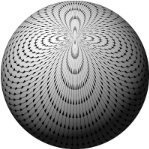-
Posts
4534 -
Joined
-
Days Won
49
joigus last won the day on March 5
joigus had the most liked content!
About joigus
- Birthday 05/04/1965
Profile Information
-
Location
(0,0,0)
-
Interests
Biology, Chemistry, Physics
-
College Major/Degree
Physics
-
Favorite Area of Science
Theoretical Physics
-
Biography
I was born, then I started learning. I'm still learning.
-
Occupation
teacher
Recent Profile Visitors
29415 profile views
joigus's Achievements

Scientist (10/13)
1.1k
Reputation
-
atom_cosmic10 started following joigus
-
Context is essential, yes, as everyone has said. As a further example, 1+1=0 is false in standard arithmetic, but it is true in mod-2 modular arithmetic. And @studiot's example of Russell's paradox is an example in which one seems to be led to the conclusion that some statements can both be true and not true. Of course, what happens is that the context, or the axioms/premises must be re-examined.
-
I don't think the distinction between generalist and specialist can be unambiguously drawn in a scenario of just 2 or 3 species. The lines get blurred, I think, precisely because the distinction is only precisely defined if/when there are plenty of resources. After all, the specialist's motto is something like "from all these so and so many resources I can only exploit this particular one". With only resources A and B, the specialist and the generalist cannot be told apart. That's what my common sense dictates anyway. I hope it makes sense. So you're right to say, I think, It's kind of like trying to define the pressure of a collectivity of two molecules!
-
Let's assume the tiger escaped from a zoo in Johannesburg...
-
I see your point. My take is that specialist vs generalist occurs in a direction with respect to the evolutionary tree, while a taxon vs another taxon occurs along a different direction. What I mean is any specialist in a given taxon has a cousin that is a generalist. It stands to reason that the more species there are, the more likely it is that a genetically-close generalist is there to fill the gap. There is no doubt that diversity is bound to take a blow any time a catastrophic event happens. Swarms of specialists will fall, and along with them relatively closely interdependent sub-niches. Conceivably, it's the generalist cousins that remain there to plant the seeds of the future biodiversity.
-
Yes, but see how dangerously close to a tautology we get? The default condition is whatever can sustain biota that will keep that condition. It's like the puddle suggested by @studiot. That was a brilliant analogy btw. Yes, I think this has to do with biodiversity being very low back during those eons --see last point by @StringJunky. Higher biodiversity will conceivable smooth out these patterns of variations. That's probably why we see those sharp banded-iron formations corresponding to the GOE. It's been speculated (but very plausibly so) that they must correspond to pulses of massive death of aerobic/anaerobic organisms and their re-births. It's like the oscillating pattern of daisy world, but with generations of aerobic/anaerobic prokaryotes playing the role of the black/white daisies, and oxygen abundance in the interstices of their bacterial mats (rather than the atmosphere) playing the role of the albedo. Well, perhaps the oversimplified way I've come to look at it. I agree with this. In fact, I've thought for some time that we usually focus too much on particular episodes just because of the particularly dramatic footprint they left behind, but the reason why we divide at all Earth time into these periods is because towards the end of each one of them, something had to give (biologically speaking) under one kind of stress or another, be it biological, cosmic, or geologically driven, or all of them together.
-
This is more or less what I meant when I said, Photosynthesis by cyanobacteria leading to the GOE no doubt came from mutations in prokaryotes, which is a genetic event, but catastrophic nonetheless. As @StringJunky said, all bets are off then. It's like the Earth setting the course to a whole new "Gaia deal" so to speak. What I fail to see is the presence of an immutable condition defining the stasis. In the case of thermodynamics, it's the equation(s) of state. In the case of living organisms, it's parameters such as pH, osmotic pressure, temperature... What on Earth (pun intended) is the go-back-to condition that defines Gaia? Agreed.
-
I did look for the journal directly on Beall's. Apparently the problem has become so bad that we have lists of lists now. I must confess I became aware of it relatively recently, although I had been suspecting of the existence of dodgy publications like these for quite some time. Reviews of Modern Physics Journal of Modern Physics...? It's a little bit on the nose, isn't it? I suppose Abidas got off to a bad start too...
-
Sonic waves? Sound consists of longitudinal pressure waves, while matter waves are essentially complex, and gauge fields satisfy transversalities (perpendicular to the direction of propagation). Matter fields and gauge fields simply cannot be longitudinal waves in a vacuum. Never mind gravity. Electrostatics is a very restrictive regime. Electrodynamics is what you should aim for. It's not the Planck scale of space and time that gives rise to h, G, and c. The implication is in the other direction.
-
Now seriously, what's the solution to EFE --and the energy-momentum distribution corresponding to it-- that does what you claim in such a colourful way? One thing is pastry, and quite a different thing is gravity. x-posted with @Phi for All
-
I think it's everybody's legs that you're pulling, not space.
-
(my emphasis) New?!! Does Спутник-1 ring a bell? The last fad from 1957, I suppose.
-
Indeed. The daisy-world model is fine to the effects of understanding basic processes of feedback operating during periods of relative stasis, or very slow variation of environmental factors. Lotka-Volterra models, IMO, do a very similar job without necessarily identifying the mechanism responsible for the feedback. Constant reproductive rates and constant coefficients of competition/predation, etc do the job of implementing these immovable conditions. When something catastrophic happens --whether cosmic, in the form of an asteroid, or internal, in the form of, e.g., an unpredictable mutation-- from the POV of the mathematician modelling it-- you would have to assume time-dependent coefficients that implement this catastrophic behaviour. Otherwise it's equilibrium solutions or oscillatory ones as long as the differential-equation model is valid.
-
Do you want to understand how DNA works in simple terms? Is that what you want? The "share" part is a bit confusing, as @zapatos pointed out. Do you mean "pass down"? There are chunks of DNA we share with all prokaryotes, even more that we share with vertebrates, still more that we share with other mammals, etc. Is that it?
-
Yes, thank you. It's true that it's usually stated that the Earth is a closed system. This might be true if you are calculating, say, primary production over a series of years, for which the flux of matter is irrelevant. Certainly not in the long run. I hope you agree with this.













